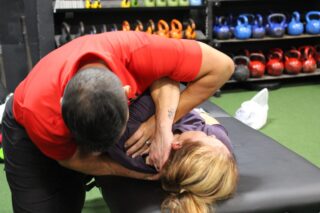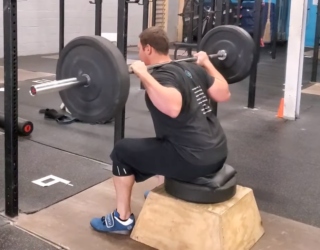Injuries suck, but if you train long enough, they are an inevitability. Unfortunately, many care providers don’t understand physical training, or how to train around injuries. The standard, cover-your-ass response from most of them is, “you hurt yourself doing [x], so stop doing [x].” That’s why we love having Dr. Raf at our facility. But for our readers who aren’t at the gym, or those whose schedules don’t work with Dr. Raf’s, we want to help you train around your injuries.

Before beginning, we need to get into the right mindset. Pain science is a complex topic, but a terrific way to look at pain is that it’s simply feedback that something is off. Similarly, when we get injured, most often it’s due to overuse, and it’s our body’s way of telling us that we’re doing something wrong. It’s on us (you, your coaches, and your rehab team) to figure out what that is.
For example, when I was about 1 month out from my first weightlifting meet, I was doing a back off set of high bar squats, and as I stood up out of the hole, it felt like a zipper was opening from the left side of my pelvis up to my rib cage. I dumped the bar and collapsed on the ground. It was about 20 minutes before I could walk. Over the next few weeks, I had to relearn to squat. It turns out, I was hyperextending my low back in my squat position. Too many reps overloaded the soft tissue, and something gave out.
How did I rehab to the point that I was able to compete 1 month later? I intuitively followed a process that the Barbell Rehab method has since codified. Here’s the 4-step process to help you train around injuries.
Step one: optimize your programming. My coach had me squatting 3 days per week. Normally, I can manage that volume. However, I was in the initial stages of running the gym. Two coaches had left, and most days I was working at least 10 hours. I averaged less than 6 hours of sleep per night, I was stressed beyond belief, and the cumulative stress effect was too much. I needed to squat less.
Optimizing programming means examining movement frequency, and modifying based not only on your training history, but also what’s happening in your life outside of the gym. I heavily modulate our movement frequency based on the calendar year (Murph, the Open, etc.), and I do my best to optimize training for the masses. But everyone is unique. Dealing with family stress? Job stress? Traveling a lot? Newborn baby? It all matters. Talk to your coach!
Step two: change modifiable factors. For me and my squat, this was my torso position and the loads I was using. It could also have been stance, tempo, depth, toe position, etc. For pressing and pulling movements, we can add grip to this. If one method of performance hurts, modify and try another.
Step three: substitute a tolerable exercise. Can’t back squat? Try a box squat, front squat, goblet squat, air squat, or split squat. Find something you CAN do, until the pain subsides. Luckily for me, I was able to skip this step in my rehab. Steps two and three, however, are really where CrossFit excels. The idea of scaling and substituting movements is foundational to its methodology. When scaling doesn’t work (load, position, etc.), we substitute similar movement patterns.

Step four: Reintegrate and rebuild. If you are using steps two or three, it’s important to work your way back to the movement that injured you. If you modified squat depth or load, we want to build you back to full depth and the weight you were using. If you substituted the exercise completely, when you feel up to it, it’s important to try the original movement, and find a way to do it that doesn’t cause pain. Slowly, we work our way back to where we were previously.
Injuries are inevitable. The most important thing to remember is that they are not permanent, and they don’t need to sideline you. You can work around them, and then through them. And you are not in this alone. Collaborate with our coaching staff, your PT’s, etc., and we’ll create a plan for you to rebuild you. Better, faster, and stronger. See you in the gym.
